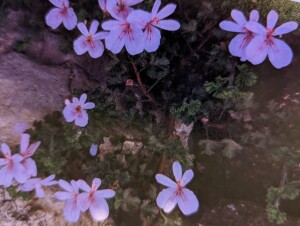 I was first smitten with scented-leaf geraniums on a visit to the Cornell Botanic Garden in Ithaca, New York. It was a sunny summer day and I passed a raised bed of vigorous geraniums near the Welcome Center. The sunshine had warmed the essential oils lurking at the bases of tiny leaf hairs, allowing visitors catch the scents of roses and lemons. It was magical.
I was first smitten with scented-leaf geraniums on a visit to the Cornell Botanic Garden in Ithaca, New York. It was a sunny summer day and I passed a raised bed of vigorous geraniums near the Welcome Center. The sunshine had warmed the essential oils lurking at the bases of tiny leaf hairs, allowing visitors catch the scents of roses and lemons. It was magical.
It was the start of an ongoing infatuation, and these days I am never without scented geraniums. They are one of the cheapest and easiest forms of aromatherapy.
Not every “geranium” is a true geranium, just as not everything called a “rose” is a true member of the Rosa clan. Scented geraniums, like the common red, white and pink varieties that ornament porches and window boxes everywhere, are officially known as pelargoniums. They are cousins of the hardy geraniums that do yeomanl-like work in many gardens, but unlike them, are tender in cold winter areas. Hardy and tender geraniums were corralled by botanists into separate genera in 1789. They have remained separate to this day, but the distinctions sometimes confuse people.
Descended from South African ancestors, all pelargonium, including garden and scented varieties belong to the large geranium or Geraniaceae family. Some, like the rose-scented Pelargonium graveolens are distinct species; others are hybrids resulting from multi-species crosses. The leaves run the gamut from tiny to large, with lobes that may be rounded, pointed, ruffled or deeply dissected. Unlike other pelargoniums, scented varieties produce relatively small flowers with five petals apiece–two large ones at the top of the flower, and three smaller ones below. Fragrance is the real attraction though, and the leaves mimic the scents of roses, lemons and other citrus fruits, pine, spice, mint, and even chocolate. The plants probably developed fragrant leaves to ward off animal and insect predators. The same quality has a powerful attraction for humans.
Interest in the scented-leaf varieties has spiked in the last twenty years or so, and the range of available varieties is large—if you know where to look. Large garden centers often carry one or two varieties in the herb section, but online vendors offer a broad range.
The citronella-scented Pelargonium citrosa is everywhere, and though its mosquito-repellent qualities are somewhat less than advertised, the leaves still have a pleasant lemony scent. Even better is little Pelargonium crispum, which has small, frilly leaves with a distinctive lemon odor. The flowers, when they appear, are white or palest lavender, with darker purple veins. ‘Lemona’, which looks like a crispum variety or hybrid, has the same ruffled leaves and lemon scent, combined with larger flowers. ‘Orange Fizz’ offers up larger leaves and a distinctly orangey scent.
The rose fragrance exuded by scented geranium leaves is the real thing, reminiscent of old-fashioned garden roses. I like three old-fashioned varieties: ‘Attar of Roses’; ‘Lady Plymouth; and ‘Grey Lady Plymouth’. I hate having to choose among plants, but if I had to pick only one of those, I would opt for ‘Grey Lady Plymouth’ because if offers a serendipitous combination of good looks and excellent fragrance. The deeply dissected leaves are edged in cream and accented at times with small, pale pink flowers. The fragrance is a complex blend—mostly rose, with a little fruit thrown in. Another old variety, ‘Rober’s Lemon Rose’ is even more complex, with a nice mix of both scents.
If you like something a little more woodsy, try ‘Select Northern Pine’, with leaves that are so finely dissected they are almost like the pine needles suggested by the rich evergreen fragrance. The small flowers are either pale purple or pink/.purple.
I usually turn to members of the dianthus family, or rugosa roses for spicy scents, but a few years ago, I bought a nutmeg-scented geranium, Pelargonium x fragrans, which has a true nutmeg fragrance. The green leaves have a grayish cast, and the fragrance is true nutmeg. Lovers of Old Spice products will adore Pelargonium x fragrans ‘Logees’, which lives up to its name.
I have grown apple-scented mint in the garden, but Pelargonium odoratissimum exudes an even more pronounced apple fragrance. It compares favorably with its hardy geranium relative, Geranium macrorrhizum or large-leafed geranium, which also smells powerfully of apple.
The best place to site a scented geranium is near seating areas or walkways, where the fragrance can be easily caught and appreciated. The plants like full sunlight, which means six hours per day. A little less probably won’t hurt, but will affect flowering and, sometimes, intensity of scent. Good drainage and adequate moisture are necessary, though pelargoniums should not be spoiled with overwatering or excessively rich soil.
In cold winter climates, grow your scented geraniums in pots and bring them inside to overwinter on a sunny windowsill. Growth will slow down, but it will not stop. My little crispum geranium is doing very nicely in my dining room, and has even managed a few flowers lately. The lemon fragrance is much less noticeable inside, but the plant’s toughness gives me hope for the future.
If you are yearning for a scented geranium, one of the best sources is New Jersey’s Well Sweep Herb Farm, which carries scores of varieties. Find them at 205 Mount Bethel Rd
Port Murray, NJ 07865-4147, (908) 852-5390, www.wellsweep.com. Their complete plant list, which is enormous, is easy to download.
